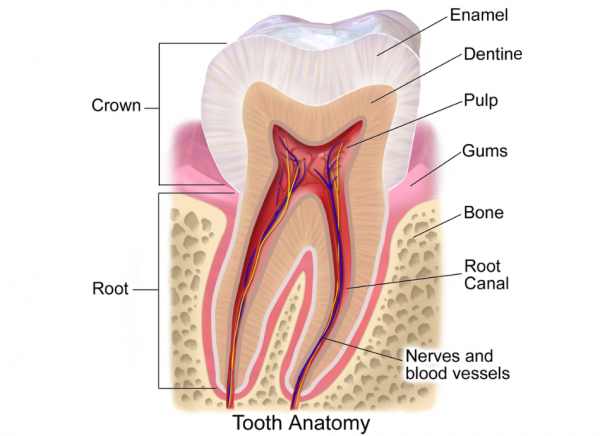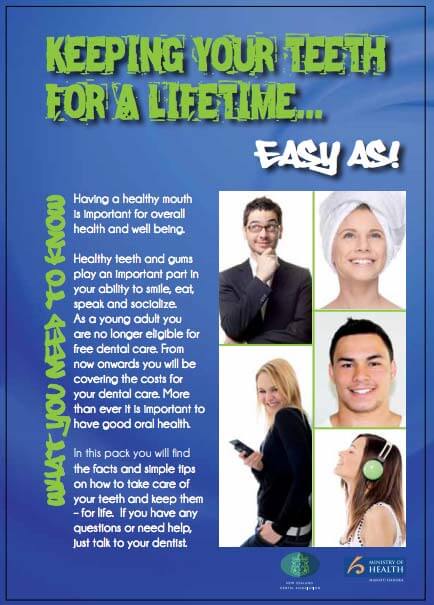Tooth wear
Also known as dental erosion, abrasion and attrition
Key points about tooth wear
- Enamel is the hard coating of each tooth. If the enamel is worn away, it uncovers the dentine underneath, which can lead to pain and sensitivity.
- There are 3 main types of tooth wear: erosion, abrasion and attrition, but erosion is the most common.
- Erosion is caused by exposure to acids found in fizzy drinks, sports drinks, energy drinks, wine, fruit juice and many sugary foods. It's a slow process that you generally don't notice until you’ve lost quite a bit of enamel.
- Once lost, enamel can't be replaced naturally, but there are treatment options to cover the enamel or protect your tooth from further erosion.
- You can prevent further enamel loss by removing sugary and acidic food and drink from your diet and following good dental hygiene practices.

Your teeth have 3 parts, the crown sits above your gumline, the neck is at the gumline and the root is under the gum and surrounded by the bone of your jaw. Teeth consist of different layers, the hard external layer is called the enamel and underneath that layer is the dentine (or dentin) and then the pulp. Tooth wear is when the enamel which has no feeling is worn away, uncovering the dentine which has feeling and can lead to pain and sensitivity.

Image credit: Wikimedia Commons(external link)
Tooth wear is term used for tooth erosion, abrasion and attrition.
- Dental erosion is the most common form of tooth wear. Most of this page will discuss dental erosion.
- Abrasion is damage to your teeth and gums by an external source, eg, over-vigorous brushing.
- Attrition is caused by an internal source, eg, tooth grinding.
When your teeth come into contact with something acidic, the enamel becomes softer for a while, putting it at risk of being eroded. Your saliva is alkaline and slowly balances out or neutralises this acidity until your mouth gets back to its natural balance.
If acid attacks happen too often, your mouth doesn’t have enough time to neutralise itself and, over time, the enamel surface starts to get destroyed.
An acid attack can come from:
- fizzy drinks, sports drinks, energy drinks, fruit juices, wine or apple cider vinegar
- food high in sugar or acid, eg, citrus fruit
- high intake of caffeine-containing products
- vomiting often, because of bulimia, hiatus hernia or oesophageal problems or drinking too much alcohol
- medicines, eg, aspirin, antihistamines, Vitamin C, some iron supplements and antibacterial mouthwashes
- a dry mouth or low flow of saliva – often as a side effect of medicines taken for other reasons
- not drinking enough water or severe dehydration following extreme exercise
- gastrointestinal (digestive) problems, eg, acid reflux disease (GORD)
- physical wear and tear from brushing your teeth too hard or flossing incorrectly, biting on hard objects (eg, fingernails, bottle caps or pens), or chewing tobacco.
You can also get a combination of erosion and abrasion from brushing straight after eating or drinking something acidic or vomiting.
Erosion usually shows up as hollows in your teeth and the tooth surface and edges wearing away. Your teeth become more yellow, as this is the colour of the dentine underneath the enamel. Because the dentine is sensitive, you may notice your teeth being more sensitive to heat and cold, or acidic foods and drinks. This sensitivity may increase as the erosion gets worse.
Diagnosis
See your dentist who will do a physical examination. Children and adults should visit a dentist or dental hygienist once a year and more often if your dentist recommends it.
Treatment
Once the enamel of a tooth is lost, it can't be replaced naturally, so prevention is better than cure. However, you can help strengthen the enamel coating through fluoride treatment, eg, toothpaste, Tooth Mousse, varnish or restorative material.
Other treatments may include fillings or crowns to protect the tooth from further decay and to make your teeth look better.
If your dental erosion is caused by another condition, eg, GORD or bulimia, this condition also needs to be treated.
Following the prevention steps in the section below will also help your dental erosion.
Once the enamel of a tooth is lost, it cannot be replaced naturally, so prevention is better than cure. However, you can help rebuild the enamel coating through fluoride treatment such as toothpaste, Tooth Mousse, varnish or restorative material.
Other treatments may include fillings or crowns to protect the tooth from further decay and make your teeth look better.
If your dental erosion is caused by another condition, such as GORD or bulimia, this condition also needs to be treated.
Following the prevention steps below will also help your dental erosion.
- Follow dental hygiene recommendations to brush your teeth twice a day with a fluoride toothpaste and to floss them once a day.
- Cut out highly acidic foods and drinks from your diet (eg, carbonated sodas, lemons, and other citrus fruits and juices). Drink milk or water instead.
- Rinse your mouth immediately with clear water after eating acidic foods, drinking acidic drinks or taking medication. Do not rinse with flavoured water as this contains sugar.
- Drink more water throughout the day, especially if your mouth is dry.
- Use a straw when you drink acidic drinks. The straw pushes the liquid to the back of your mouth, limiting the number of teeth it touches.
- If you eat or drink anything acidic, wait for about half an hour before brushing your teeth. Brushing straight after acidic foods and drinks may cause even more enamel damage.
- Avoid snacking between meals. Your mouth is acidic for a few hours after eating foods high in sugar and starches, so snacking increases the chance of tooth decay.
- Chew sugar-free gum after meals. This boosts saliva production to up to 10 times the normal flow for a short while, which helps neutralise the acid faster.
The following links provide further information about dental erosion. Be aware that websites from other countries may have information that differs from New Zealand recommendations.
Teeth and gums(external link) Health New Zealand | Te Whatu Ora
Dental erosion(external link) Better Health, Australia
Brochures
Teeth care for families(external link) HealthEd, NZ available in the following languages: English(external link), Cook Islands Māori(external link), te reo Māori(external link), Niuean(external link), Samoan(external link), Tokelauan(external link), Tongan(external link)
Caring for teeth(external link) HealthEd, NZ
Keeping your teeth for a lifetime(external link) Healthy Smiles, NZ
Erosion(external link) University of Adelaide, Australia
References
- About your tooth(external link) Mayo Endodontics, US
- Dental erosion(external link) Oral Health Foundation, UK
- Dental remineralization – simplified(external link) Oral Health Group, US, 2012
- Erosion(external link) University of Adelaide, Australia, 2016
Dental erosion – etiology, diagnosis and prevention(external link) American Dental Association, 2011
Li X, Wang J, Joiner A, Chang J.The remineralisation of enamel – a review of the literature(external link) J Dent. 2014 Jun;42 Suppl 1:S12-20
Kilpatrick N, Mahoney EK. Dental erosion Part 2 – The management of dental erosion [PDF, 132 KB] NZ Dent J. 2004 June;100(2):42–47
Brochures

HealthEd, NZ, 2022
English, Cook Islands Māori, te reo Māori, Niuean, Samoan, Tokelauan, Tongan

HealthEd, NZ, 2022

Healthy Smiles, NZ, 2012
Credits: Healthify editorial team. Healthify is brought to you by Health Navigator Charitable Trust.
Reviewed by: Sophie McKenna, General Dental Surgeon
Last reviewed:





